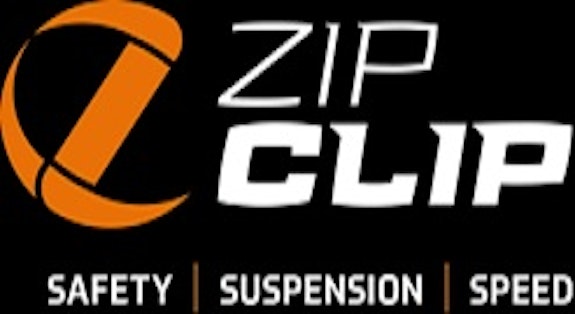Zip Clip
Welshpool based Zip Clip manufactures high specification suspension systems that offer a unique “fusion of engineering and design”.
Learning points
- High speed connectivity can provide a high return on investment, potentially providing year-on-year savings.
- Cost savings are coupled with time savings, with the journey from concept to delivery using superfast technologies, taking far less time to complete.
- Computer aided design packages are supported by high download speeds, allowing for quick and efficient international sales and distribution.
Overview of the business

Zip Clip's innovative wire suspension systems are manufactured from high quality zinc alloy, replacing the traditional threaded rod used previously in construction. The wire suspension systems are quicker and easier to install, as well as offering additional benefits, such as a tidy, light, and more environmentally friendly finish.
The versatile suspension solution is installed nationally and internationally to fulfil a number of construction requirements, helping with the installation of electrical equipment, HVAC (heating, ventilation and air conditioning technology), signage, and seismic systems. At present, 60 percent of the sales are domestic and 40 percent are exports. Though, the business looks to switch these portions, with the majority of sales being exported internationally. Currently, international sales are made to the United States, South Africa, China and the United Arab Emirates. The business is also extending its operations overseas with a new branches opening in France, Australia and New Zealand.
Beyond sales, Zip Clip looks to long-term and good quality relationships with suppliers and distributors from across the world. The team works closely with its partners to gain trust and develop long-term relationships.
While now an expanding global enterprise, the business started 13 years ago with the two founders undertaking the manufacturing and sales roles. By 2017 this number had increased to 37 full-time staff, with the aim of expanding its business 20 percent year on year. The initial start-up of the business benefited from financial and advisory assistance from the Welsh Government.
Innovation is in-built into the ethos of the company, with its team constantly looking for new solutions in the construction industry. A core element of this innovation is the maximisation of broadband enabled digital technologies.

Zip Clip information flow diagram
Highlighting the internal and external communication flows of the business.
If this document cannot be read by your assistive software, you can request an accessible version by emailing web@cardiff.ac.uk. Please include the assistive tools you use and the format you require.
Superfast broadband adoption
Zip Clip benefited from early adoption of superfast broadband. The previous installation and running cost was approximately £2,500 a year, which was considered a worthwhile and essential investment. When moving to its new headquarters site in Welshpool, access to superfast broadband was initially lost. By mid-2017, fibre connectivity had been facilitated for the new location and the company was able to re-gain access to superfast broadband speeds.
IT skills capacity
ICT is an essential component within the business model. The company invests significantly in up-to-date hardware and software. Within the last 12 months £4,000 was spent on remote access computers and a further £5,000 for office computers. Moreover, laptops are being replaced with iPads to allow for portable access offsite.
Staff training in ICT is a priority, with ongoing training throughout the year and specialised training when new equipment is installed. Recent staff training relates to the installation of Voice over Internet Protocol (VoIP) telephone equipment.
ICT and backup are outsourced to an external company carefully selected to meet the specific business requirements. ICT support covers any problems, from email, Internet security, PC faults, to Internet connectivity. The support is accessed both remotely and through direct contact. These ICT specialists also provide external servers.
The business supports a remote working infrastructure, with widespread access to iPads with mobile Internet. As a result, all technical managers are able to work remotely. However, there is a move back toward traditional in-house working formats because of the considered benefits of collegiality and work place interaction. Onsite employees are able to communicate through traditional and digital channels.
Use of digital technologies
Digital technology is fundamental to the business and its daily operations covering all business functions (see Figure 1) from sales delivery, advertising, and marketing:
The market is changing very, very quickly now and we've got to keep up with the pace of that, and keep ahead of it.
Responding to the frequent shifts in the competitive market, the company constantly updates its website and social media presence.
Cloud-based technology is increasingly commonplace, with large amounts of cloud-based packages been utilised across the business. Examples include the accounting and finance packages, banking, customer relationship management (CRM), and delivery tracking. Sage is pivotal to the business, running sales order processing, delivery notes, goods inwards, goods outwards and shipping. This is accessed through the cloud.
Instant, reliable and remote communication provides a significant boost to the business when operating offsite. At the centre of this is Total Live Communications (TLC), whereby live streaming is accessed through a smartphone or tablet when surveying a site. These facilities are used when providing technical support from the office and when documenting the completion of the installation. Instead of sending technical support to the installation site, the communication is operated via a live link from the premises to the installation site.
External communication is also important. Having recently installed VoIP, communication with suppliers and distributors nationally and internationally is becoming easier. It is hoped that it will ease the transition toward an in-house conference facility. This supports the existing video conferencing facilities, with Skype and Viber being regular options used to communicate with its international clients.
Importantly, Zip Clip relies on computer aided design (CAD). By having access to high speed Internet and enabled technologies, the business is able to access and amend 3D drawings on iPads and send these to clients through email and cloud-based storage. High download speeds are essential when downloading and transmitting these large files.
Business performance
High speed connectivity provides a massive boost to the company in terms of cost saving, speed of decision delivery, and environmental responsibility.
A noteworthy saving relates to time:
To share that information that quickly with our sales team and being able to access it throughout the world, yes, the cloud is the best way to do it.
On average, the suspension wire goes from concept to finish in just 30 days, a huge reduction from the previous average of approximately three months. One way in which delivery times are reduced relates to the ability to design and send 3D drawings to clients overseas. Whereas previously a team would travel to client and articulate the designs, this is now done through the Internet and CAD 3D drawings.
Additionally, outgoings can be significantly reduced with access to these broadband enabled services. The business estimates that the use of 3D drawings transmitted digitally saves up to £5,000 on long haul flights and accommodation.
The TLC system also provides key savings. The technical manager is able to offer instant support to anywhere in the world, saving large sums in transport and accommodation. It is estimated that sending the technical manager to installation sites cost on average £600 to £700. With the aid of broadband and the TLC system, the manager is able to cover three or four sites daily, while remaining on Zip Clip premises.
Therefore, while superfast broadband is an outlay of approximately £2,500 a year, it is estimated, conservatively, to be saving between £10,000, to £15,000 a year for the business.
